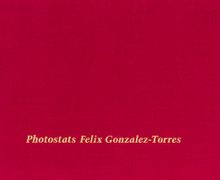| |||||||||||||||||||||||||
ARTIST MONOGRAPHS
|
|
STATUS: Out of stock indefinitely. |
 Felix Gonzalez-Torres: Photostats
Felix Gonzalez-Torres: Photostats
Published by Siglio.
Edited by Lisa Pearson, Richard Kraft. Text by Mónica de la Torre, Ann Lauterbach.
Felix Gonzalez-Torres (1957-96) is one of the most significant artists to have emerged in the 1980s. An artist whose beautiful, restrained and often mutable works are abundant in compelling contradictions, Gonzalez-Torres was committed to a democratic form of art informed as much by the aesthetic and conceptual as by politics. His work challenges authority and our obeisance to it, dissolves the delineations between public and private, and creates a rich, open field into which the viewer is invited to complete works with her own inferences, imagination, and actions.
The photostats are a series of fixed works with white text on black fields framed behind glass to create a reflective surface bringing the viewers' reflection into the work. Made at the height of the AIDS crisis, these profoundly suggestive lists of political, cultural, and historical references disrupt hierarchies of information and linear chronology, asking how we receive and prioritize information, how we remember and forget, and how we continuously create new meaning. The photostats also recall the screens (the television, and now the computer) which furiously deliver information from which we must parse substance from surface and choose what to assimilate and what to reject.
This elegant volume is a discrete space in which to closely read the photostats with sustained attention: it opens from both sides, reproducing the framed photostats as objects on one, and from the other, details of the texts can be read as writing. In between the two, original writings by Mónica de la Torre and Ann Lauterbach, explore adjacent territories, signaling the multiple entry points for understanding the works.
PUBLISHER
Siglio
BOOK FORMAT
Clth, 8.25 x 6.5 in. / 88 pgs / 26 bw.
PUBLISHING STATUS
Pub Date 11/20/2020
Active
DISTRIBUTION
D.A.P. Exclusive
Catalog: FALL 2020 p. 64
PRODUCT DETAILS
ISBN 9781938221262 TRADE
List Price: $36.00 CAD $50.40 GBP £32.00
AVAILABILITY
In stock
in stock $36.00 Free Shipping UPS GROUND IN THE CONTINENTAL U.S. |
 Felix Gonzalez-Torres: Specific Objects Without Specific Form
Felix Gonzalez-Torres: Specific Objects Without Specific Form
Published by Koenig Books.
Text by Elena Filipovic, Danh Vo, Carol Bove, Tino Sehgal.
With the profound visual and conceptual potential of Gonzalez-Torres’ work in mind, Filipovic devised an exhibition structure that entailed two autonomous-yet-adjacent exhibitions of his work at each of the three venues: one iteration by her, and one by Vo, Bove and Sehgal respectively. This volume follows the show’s structure. Each venue has a dedicated section which includes a preface by Filipovic, photographic documentation of each exhibition and a contribution by Vo, Bove and Sehgal reflecting upon their positions as curators of Gonzalez-Torres’ work.
Danh Vo includes photographs of diagrammatic brass wall plaques as presented within his installation at WIELS; Carol Bove offers an essay describing her personal experiences with the work of Gonzalez-Torres and the curatorial scope of her installation; and Tino Sehgal recorded a conversation with Andrea Rosen—Gonzalez-Torres’ lifelong art dealer—which captures part of their rich dialogue around the artist’s work.
A comparative illustrated checklist documents each of the 85 works by Gonzalez-Torres featured in all their iterations. This invaluable resource showcases the radical and expansive nature of Gonzalez-Torres’ work as envisioned through the remarkable and unique voices of this important generation of artists, alongside the curatorial insight of Elena Filipovic.
Elena Filipovic is director and chief curator of Kunsthalle Basel in Basel, Switzerland.
PUBLISHER
Koenig Books
BOOK FORMAT
Hardcover, 7.5 x 11 in. / 664 pgs / 595 color.
PUBLISHING STATUS
Pub Date 2/28/2017
Out of stock indefinitely
DISTRIBUTION
D.A.P. Exclusive
Catalog: SPRING 2017 p. 94
PRODUCT DETAILS
ISBN 9783863359737 FLAT40
List Price: $70.00 CAD $92.50
AVAILABILITY
Not available
STATUS: Out of stock indefinitely. |
 Félix González-Torres
Félix González-Torres
Published by Steidl.
Edited by Julie Ault. Text by Robert Storr, Miwon Kwon, et al.
PUBLISHER
Steidl
BOOK FORMAT
Clth, 8.25 x 10.75 in. / 400 pgs / 400 color.
PUBLISHING STATUS
Pub Date 11/22/2016
Out of stock indefinitely
DISTRIBUTION
D.A.P. Exclusive
Catalog: SPRING 2015 p. 99
PRODUCT DETAILS
ISBN 9783869309217 TRADE
List Price: $65.00 CAD $87.00
AVAILABILITY
Not available
STATUS: Out of stock indefinitely. |
 Felix Gonzalez-Torres
Felix Gonzalez-Torres
Published by Guggenheim Museum Publications.
By Nancy Spector.
Written by Nancy Spector in close consultation with the artist and reflecting and expanding upon his ideas at the time, Felix Gonzalez-Torres presents a thematic overview of the artist's rich, many-layered practice, including the signature paper stacks, candy spills, light strings and billboards--and demonstrates his continued resonance today.
Nancy Spector is Chief Curator at the Guggenheim Museum, New York, and U.S. Commissioner to the 2007 Venice Biennale.
PUBLISHER
Guggenheim Museum Publications
BOOK FORMAT
Hardcover, 6 x 9 in. / 228 pgs / 172 color.
PUBLISHING STATUS
Pub Date 5/1/2007
Out of print
DISTRIBUTION
D.A.P. Exclusive
Catalog: FALL 2007 p. 75
PRODUCT DETAILS
ISBN 9780892073627 TRADE
List Price: $45.00 CAD $55.00
AVAILABILITY
Not available
STATUS: Out of print | 00/00/00 For assistance locating a copy, please see our list of recommended out of print specialists |
 Felix Gonzalez-Torres: America
Felix Gonzalez-Torres: America
Published by Guggenheim Museum Publications.
Edited by Nancy Spector. Conversation with Ann Goldstein, Susanne Ghez, Amada Cruz.
PUBLISHER
Guggenheim Museum Publications
BOOK FORMAT
Paperback, 7.5 x 5.5 in. /76 pages /28 illustrations.
PUBLISHING STATUS
Pub Date 7/1/2007
Out of print
DISTRIBUTION
D.A.P. Exclusive
Catalog: FALL 2007 p. 75
PRODUCT DETAILS
ISBN 9780892073665 TRADE
List Price: $25.00 CAD $30.00
AVAILABILITY
Not available
STATUS: Out of print | 4/1/2008 For assistance locating a copy, please see our list of recommended out of print specialists |
 Felix Gonzalez-Torres
Felix Gonzalez-Torres
Catalogue Raisonne
Published by Cantz.
Artwork by Felix Gonzalez-Torres. Contributions by Roland Waspe. Text by Dietmar Elger, Andrea Rosen.
PUBLISHER
Cantz
BOOK FORMAT
Hardcover, 9.75 x 12.25 in. / 296 pgs / 60 color / 240 bw
PUBLISHING STATUS
Pub Date 7/2/1997
Out of print
DISTRIBUTION
D.A.P. Exclusive
Catalog: FALL 1997
PRODUCT DETAILS
ISBN 9783893228836 TRADE
List Price: $65.00 CAD $75.00
AVAILABILITY
Not available
STATUS: Out of print | 10/23/2003 For assistance locating a copy, please see our list of recommended out of print specialists |
